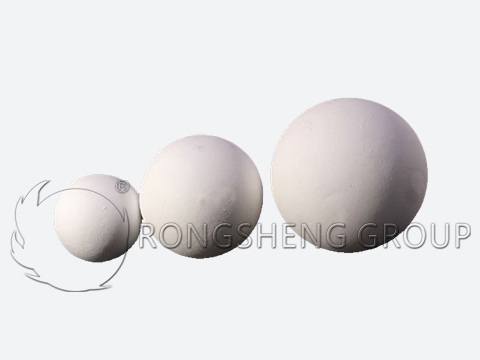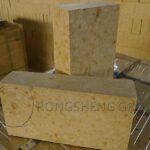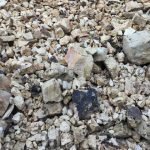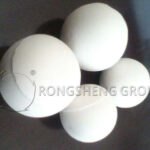Alumina ceramics are special structural ceramics with the most mature industrialization technology, the largest production scale, and the widest application fields. Porcelain balls with an alumina content of more than 90% have the characteristics of high hardness, high density, low wear, corrosion resistance, and high-cost performance. As a grinding media, it is widely used in building sanitary ceramics, industrial ceramics, electronic ceramics, high-grade refractory materials, special cement, non-metallic minerals, coatings, paints, and other industries.
The building materials industry standard JCT848.1-2010 has strict technical requirements for the appearance quality and physical and chemical properties of wear-resistant alumina ceramic balls. However, various defects may occur in alumina ceramic balls during the production process. It is particularly important to discover defects in time and improve the overall quality of alumina ceramic balls through process adjustment and optimization.

Common Quality Defects of High Alumina Ceramic Balls
At present, the high-alumina ceramic balls produced at home and abroad mainly use α-alumina powder as the main raw material. It is made through multiple processes such as batching, ball milling, molding and high-temperature firing. The main molding methods include semi-isostatic pressing (dry bag method) molding, isostatic pressing molding and roll molding. The main firing kilns include high-temperature tunnel kilns and shuttle kilns. Common quality defects of high alumina ceramic balls are:
- (a) Appearance quality defects, such as spots, blistering, sticking damage and wind crystals.
- (b) Performance defects, including waist cracks, raw burns, heavy wear and nail marks.
Through testing of high-alumina porcelain balls at home and abroad, it was found that nail mark defects exist in large-size products of high-alumina porcelain balls to varying degrees, and are difficult to completely eliminate. Therefore, this article focuses on the causes and countermeasures of nail pattern defects.
Cause Analysis and Treatment Methods of Common Quality Defects
1 Spots
Because the body of the high alumina porcelain ball is white, if spots appear, they will be particularly obvious and easy to spot. According to the number and size of spots, it can be roughly divided into the following three situations.
- (1) There are fewer spots and the diameter is less than 1mm. The spot defects that occur in this situation are mainly caused by iron impurities in α-alumina powder and the iron content in various auxiliary materials exceeding 0.3%.
- (2) There are many spots and the diameter is less than 2mm. This may be caused by bricks falling off the ball mill, or the slurry not removing iron during the ball milling and spraying processes.
- (3) Spots appear on the top layer, and the spots are larger. This is usually caused by rust being brought into the kiln preheating air duct or refractory bricks falling into the product surface.
In summary, in order to reduce or eliminate spot defects, pure alpha alumina powder and other auxiliary raw materials should be used. Iron removal is required multiple times during slurrying, powder spraying and material discharging. And clean the iron remover in time, and clean the air ducts of the kiln regularly.
2 Blistering
Blistering defects generally occur in high-alumina ceramic balls produced by roll-forming processes. Because during roll forming, the finished ball blank grows up through the collision of many semi-finished balls and completes the densification process. Before the rolling is finally completed, 10 to 120 minutes of polishing is required to adjust the sphericity and surface finish of the semi-finished ball blank. During firing, due to the high surface temperature of the ball blank, it is first sintered and forms a dense surface layer, which hinders the evaporation and discharge of internal moisture, resulting in blistering on the surface of the finished porcelain ball. Based on the above principles, blistering defects can be eliminated by the following methods:
- (1) During the process of rolling the high-alumina ceramic ball body, both the density and smoothness of the semi-finished product should be taken into consideration. At the same time, try to reduce the polishing time before serving.
- (2) Reduce the content of low-temperature fluxes and high-temperature volatile substances in the formula.
- (3) Dry the moisture content of the semi-finished product before firing so that the moisture content cannot exceed 0.3%.
3 Sticky Loss
Sticky defects of porcelain balls are relatively common. High-alumina ceramic balls are fired using a high-temperature process, and the temperature can reach as high as 1520°C. In order to ensure the performance of fired products, it is often necessary to maintain heat preservation at high temperatures for 2 to 10 hours. Once more liquid phase appears at high temperature, adhesion loss will occur between ceramic balls and between ceramic balls and silicon carbide boron plates. How to deal with this problem:
- (1) Isolate between porcelain balls and porcelain balls, porcelain balls and silicon carbide boron plates, porcelain balls and columns, by spreading corundum sand, placing corundum backing plates, etc.
- (2) While taking into account the output, reduce the kiln installation height of each layer of porcelain balls.
- (3) Design the solid-phase sintering formula to reduce the glass phase appearing inside the ceramic ball. Calculate at the lower limit of the calcining temperature range and extend the holding time appropriately. The above measures can effectively solve the problem of sticking loss and improve the product qualification rate.
4 Wind Crystal
The wind crystal defect refers to the wind crystal explosion that occurs in the high alumina ceramic balls in the kiln cooling zone. This is mainly because the product has reached densification under high-temperature firing, and the sintered and porcelain high-alumina ceramic balls have smaller porosity. When cooled to 570°C and 790°C, the quartz phase transformation produces a large volume change, causing the product to explode. Therefore, once the wind crystal explodes,
- If it is a roller kiln or tunnel kiln, it is necessary to promptly reduce the speed of the kiln car, reduce the air inlet volume of the cooling zone, adjust the height of the product loading kiln, and avoid cold air blowing directly to the hot products.
- If it is a shuttle kiln, just reduce the cooling air inlet volume.
Wind crystal burst occurs more often in roll-formed large-size (generally φ20mm or more) ceramic balls, and rarely occurs in semi-isostatically pressed or isostatically pressed high-alumina ceramic balls. This is because it is difficult for roll-formed ceramic balls to release the stress caused by the phase transformation of quartz. Therefore, when designing the composition and formula of high-alumina ceramic balls prepared by roll-forming, the possibility of free SiO2 should be reduced as much as possible. It is best to consider promoting the formation of a certain amount of mullite or spinel in formula design to prevent the occurrence of wind crystal defects.
5 Lumbar Fissure
Waist crack is a defect that is difficult to be directly discovered and detected in products coming out of the kiln. It is an annular crack that appears on the surface of a high-alumina ceramic ball after it is pre-ground. The cracks are mostly located about 5mm below the spherical crown, hence the name. When the defect is serious, there will be a crack with a width of 0.5mm surrounding the ceramic ball. Ceramic balls containing this defect will cause serious quality accidents such as broken balls and cracked balls during use. According to our experience, this kind of crack already exists in semi-finished ball blanks, and mainly occurs in fully automated semi-isostatically pressed ceramic balls. The main reason is that the powder has large hollowness and poor fluidity, resulting in a large amount of high-pressure sealed gas generated during the molding process that cannot be eliminated smoothly and timely. As a result, crack areas are left in patches during the firing and exhausting process. After pre-grinding off the outer layer of the high-alumina ceramic ball, the waist cracks are revealed.
When waist crack occurs, the preliminary raw material preparation process must be adjusted in time to increase the fluidity of the powder and extend the pressure relief and pressure holding time of the press. Use kerosene to soak and screen semi-finished products (the semi-finished products can only be seen after breaking them open). If the semi-finished ball stone is abnormally shaped, the rubber mold needs to be replaced. Extend the heating time during which the product passes through the temperature range of 1,000 to 1,300°C. Taking the above measures can completely solve the problem of waist cracks in high-alumina ceramic balls.
6 Grilled Raw
Raw firing defects refer to the situation where the physical and chemical properties of high-alumina ceramic balls are not up to standard due to insufficient sintering and densification. Generally, it can be judged by testing the water absorption rate, specific gravity and other indicators of the ceramic ball. If the high-alumina ceramic balls are burned, simple power outages, gas outages and other production factors are excluded. The direct reasons analyzed from a technical perspective may include: batching errors, coarse slurry particle size, insufficient ball milling time, molding pressure and kiln temperature fluctuations, etc. When all the above process control points are confirmed to be error-free, it is necessary to consider replacing the alpha alumina powder and formula.
7 High Wear and Tear
The large wear defect means that under normal production conditions of high-alumina ceramic balls, the wear of some products suddenly becomes large, exceeding the normal fluctuation range, and cannot be judged as qualified products. As an important indicator of grinding media, abrasion directly affects the quality of high alumina ceramic balls. The main reasons for large wear and tear are:
- (1) The performance indicators of raw materials have dropped sharply and there are many impurities.
- (2) The high-alumina ceramic balls appear to be burning.
- (3) The internal grains of the high-alumina ceramic balls grow abnormally, and a large number of pores are produced by over-firing.
- (4) The formula system is unstable and the firing temperature is narrow.
In case of sudden increase in wear, a stable raw material supplier should be selected. Every batch must be inspected. If you encounter unqualified raw materials, try not to use them and use them as little as possible. High-alumina porcelain balls that appear to be burned must be refired. Reduce the maximum firing temperature of the kiln and extend the holding time to avoid abnormal grain growth due to over-firing. At the same time, the internal firing uniformity of the high-alumina ceramic balls is ensured. Re-select a formula system with a wider firing temperature. And a trace amount of MgO can be added to form magnesia-aluminum spinel at the grain boundaries to inhibit abnormal grain growth.
8 Nail Pattern
Nail pattern defects are common in high-aluminum porcelain ball products at home and abroad, and the larger the size of the product, the more nail patterns there are. Nail marks cannot be detected in semi-finished products. They can only be discovered after pre-grinding with high-alumina ceramic balls. They are distributed as curved, intermittent cracks on the surface of the product. As the ball milling time prolongs, the nail pattern will also become deeper and wider. High-alumina ceramic balls with nail patterns will cause problems such as slag shedding and high wear when used as grinding media. The appearance of nail marks is related to the entire technical process system of high-alumina porcelain ball production. To sum up, the main reasons are as follows:
8.1 Problems in the Use of Raw Materials
High-aluminum porcelain balls use α-phase alumina powder as the main raw material. The conversion rate of α-phase alumina powder directly determines the number of nail patterns in the product. If the α-phase conversion rate does not reach more than 92%, the large amount of γ-phase alumina powder contained in it will cause shrinkage phase change during the product firing process, resulting in the appearance of nail lines.
8.2 Problems with the Milling Process
The powder of high alumina ceramic balls is prepared by pressure spray drying of slurry. The viscosity and moisture of the slurry determine the particle gradation, sphericity, bulk density and sticky powder of the obtained powder. If most of the powder has insufficient sphericity, poor fluidity, and hollow powder, closed pores will appear in the pressed semi-finished product. During the sintering process of high alumina ceramic balls, since the pores will be transmitted along the grain boundaries, connected closed pores will eventually be formed. During the ball milling process, the closed pores have a lower strength than the surrounding environment, resulting in curved nail patterns.
8.3 Binder Issues
High alumina ceramic balls are all molded using dry powder. In order to improve the semi-finished product yield and semi-finished product strength during semi-isostatic pressing and isostatic pressing molding processes, a large amount of binder is often added to the formula. The adhesive will produce a large amount of ash and high-pressure gas during the sintering process of the product, which cannot be smoothly discharged internally, resulting in nail marks. Therefore, the amount of binder used should be reduced or additives that leave no residue after burning should be used.
8.4 Molding Pressure Issues
Nail pattern defects are less common in roll-formed products because the impact of the rolling process destroys the original powder structure. When high-alumina ceramic balls are formed by semi-isostatic pressing and isostatic pressing, the current design pressure cannot completely crush the internal structure of the raw material powder. The semi-finished product is not dense enough, causing nail marks inside the fired product. By comparing domestic and foreign high-alumina porcelain ball products, it was found that the greater the molding pressure, the fewer nail marks. Isostatically pressed products have fewer nail marks than semi-isostatically pressed products.
8.5 Firing Issues
Firing is also very important when high alumina porcelain balls eliminate nail pattern defects. Excluding issues with kiln design, the firing temperature, holding time, and heating curve directly determine the amount of nail pattern. During the firing process of high alumina porcelain balls, there are complex processes such as volatilization of free water and crystal water, shrinkage, phase change, and recrystallization. For this reason, in the process of rapid firing shrinkage in the range of 1000 to 1350°C, the heat preservation time must be extended. At the same time, the temperature difference in the firing zone should not exceed 5°C to avoid inconsistent firing.
Conclusion
Through the above analysis and summary of common quality defects of high alumina ceramic balls at home and abroad, it is not difficult to find that controlling and eliminating these defects mainly requires starting from the following aspects.
- Use optimized raw materials and formula systems to increase its stability and practicality.
- Strictly control and adjust the powdering process to prepare solid granulated powder with good fluidity, high sphericity.
- According to the use requirements of the product, the corresponding high-alumina ceramic ball blank is prepared using an appropriate molding process. There are different types of firing defects in ball blanks caused by different molding processes, and the measures to eliminate defects are also different.
- Reasonable firing process is particularly important, which directly determines the final performance of the product to a large extent.
If the above countermeasures are effective, the product qualification rate and overall product performance of high alumina ceramic balls will be greatly improved.








